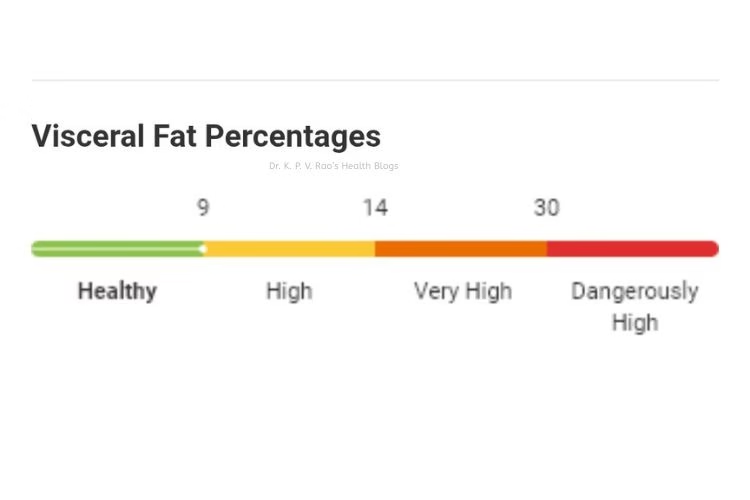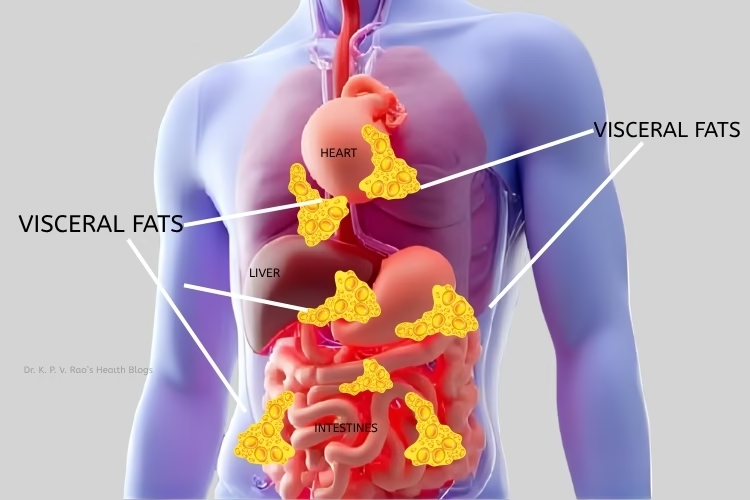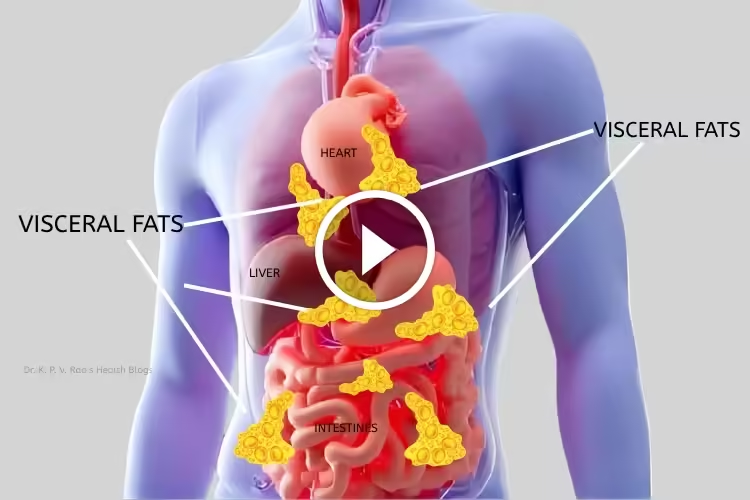What is Visceral Fat and Its Normal Values
Hello friends,
In my last article on Dexa Scan, I had mentioned one of the uses of getting a dexa scan was knowing your whole body composition and that included measuring subcutaneous and Visceral Fat.
Visceral fat, also known as intra-abdominal fat, is a type of fat that accumulates within the abdominal cavity, surrounding vital organs such as the liver, pancreas, and intestines. Other than that, it also surrounds the heart.
This type of fat is distinct from subcutaneous fat, which resides just beneath the skin.
While subcutaneous fat serves as an energy reserve and provides insulation, visceral fat plays a more complex role in the body’s metabolism and can have detrimental effects on health when present in excess.”
Visceral fat is biologically active and produces various hormones and inflammatory substances, which can disrupt normal metabolic functions.
To understand this, please read this downloadable PDF document-
High levels of visceral fat are associated with increased risks of metabolic syndrome, cardiovascular diseases, type 2 diabetes, and certain cancers.
This makes understanding and monitoring visceral fat levels critical for maintaining overall health.
Normal values of visceral fat can vary based on gender, age, and individual physiology.
Typically, waist circumference is a practical metric for assessing visceral fat levels, with a cutoff of 40 inches for men and 35 inches for women being indicative of an increased risk of health issues. Measuring waist-to-hip ratio can also provide insights, as higher ratios suggest higher levels of visceral fat accumulation.
Advanced imaging techniques, such as MRI, CT scans and DEXA Scans, offer precise assessments of visceral fat distribution but are often not necessary for routine evaluations.
Instead, the combination of waist circumference and body mass index (BMI) serves as effective tools for determining health risks associated with visceral fat.
Values exceeding the recommended ranges may prompt further investigation such as the Dexa Scan and lifestyle modifications to mitigate health risks.
Therefore, understanding the normal values and implications of visceral fat is vital for adopting proactive measures towards health and well-being.
The Dangers of Excessive Visceral Fat
Visceral Fat and Its Normal Values
Excessive visceral fat is a significant health concern, primarily because it resides deep within the abdominal cavity, surrounding vital organs such as the liver, pancreas, and intestines.

Unlike subcutaneous fat, which is located just beneath the skin, visceral fat poses greater risks due to its metabolic activity.
Scientific studies have revealed a strong correlation between high levels of visceral fat and various serious health conditions, highlighting the importance of monitoring and managing this type of fat deposit.
One of the most alarming risks associated with excessive visceral fat is the development of type 2 diabetes.
This fat type can lead to insulin resistance, a condition where the body’s cells do not respond effectively to insulin, resulting in elevated blood sugar levels.
According to research, individuals with higher visceral fat levels are significantly more likely to develop insulin resistance, which can progress to type 2 diabetes if not managed properly.
Additionally, visceral fat is a known contributor to cardiovascular diseases. It generates inflammatory substances that may disrupt normal cardiovascular function and promote atherosclerosis—the buildup of fatty deposits in the arteries.
Numerous studies have established that individuals with higher levels of visceral fat have an increased risk of heart disease and hypertension, complicating their overall health status.
Metabolic syndrome is another condition closely linked to excessive visceral fat.
This syndrome is characterized by a cluster of risk factors—including increased blood pressure, elevated blood sugar, excess body fat around the waist, and abnormal cholesterol levels—that collectively heighten the risk of heart disease, stroke, and diabetes.
Research has shown that visceral fat accumulation can significantly increase the likelihood of developing metabolic syndrome, serving as a clear indicator of potential health issues.”
Given these alarming associations, it is crucial to track visceral fat levels for the sake of long-term health.
Understanding the dangers posed by excessive visceral fat can empower individuals to adopt healthier lifestyle choices, monitor their body composition, and consult healthcare professionals as necessary.
By addressing this type of fat effectively, one can mitigate the associated health risks and enhance overall well-being.
Healthy Ranges for Visceral Fat:
Visceral fat calculator
Understanding the healthy ranges for visceral fat is integral for maintaining overall health.
Visceral fat, most often referred to as abdominal fat, surrounds vital organs like heart, liver, kidneys etc., and can have significant implications for one’s health if the level is above 9%.”

Various health organizations provide guidelines that help individuals gauge their levels of visceral fat and understand the potential risks associated with excessive accumulation.
Generally, a commonly accepted measure of visceral fat is waist circumference.
For men, a waist size above 40 inches is considered high, while for women, a waist size exceeding 35 inches is often deemed excessive. These measurements serve as key indicators of increased visceral fat, which may heighten the risk of cardiovascular diseases and diabetes. However, it is essential to recognize that these figures can vary based on several factors, including body type, gender, and age.
For example, the distribution of fat can differ among individuals with distinct body shapes, such as apple or pear shapes.
Moreover, hormonal changes, particularly during menopause for women, can lead to an increase in abdominal fat.
Useful Resource- Cleveland Clinic on Visceral Fats
Age also plays a role, as metabolic rates tend to decrease with advancing years, potentially contributing to greater visceral fat accumulation. Therefore, it is crucial for individuals to be aware of these influences when assessing their visceral fat levels.
Professional recommendations suggest that individuals maintain a balanced lifestyle, incorporating regular physical activity and a nutritious diet to help manage visceral fat. Engaging in aerobic exercise and strength training can aid in reducing it effectively, thereby promoting better health outcomes. .
Effective Strategies to Reduce Excess Visceral Fat
Managing and reducing excess visceral fat requires a multifaceted approach that includes
- diet modifications,
- regular physical activity, and
- stress management techniques.
Incorporating these strategies not only promotes a healthier body composition but also significantly lowers the associated health risks linked to visceral fat.
A balanced diet plays a crucial role in reducing visceral fat levels. Focus on whole, nutrient-dense foods such as fruits, vegetables, whole grains, lean proteins, and healthy fats.
Limiting the intake of processed foods, sugary beverages, and high-fat snacks can further aid in curbing this form of fat. Additionally, incorporating dietary practices like the Mediterranean diet, which emphasizes healthy fats and lean proteins, can be beneficial. Research suggests that diets rich in fiber can help manage weight and reduce visceral fat, thereby enhancing overall health.
Regular physical exercise is fundamental in combating visceral fat. Aim for a combination of aerobic activities, such as walking, swimming, or cycling, along with strength training exercises.
The World Health Organization (WHO) recommends at least 150 minutes of moderate aerobic activity or 75 minutes of vigorous activity per week, supplemented by muscle-strengthening activities on two or more days. Such a regimen may effectively diminish visceral fat levels and improve metabolic health.
Stress management should not be overlooked, as chronic stress can contribute to an increase in visceral fat.
Techniques such as meditation, yoga, or tai chi can promote relaxation and help mitigate stress-related weight gain.
Additionally, ensuring adequate sleep is crucial since poor sleep quality is associated with increased visceral fat accumulation.
For various individuals, medical interventions might be necessary, especially when lifestyle modifications do not yield sufficient results.
In case the above methods don’t work, consult a your doctor about potential prescription medications aimed at managing weight or available surgical options that specifically target visceral fat.
Several studies indicate that a comprehensive approach encompassing both lifestyle changes and medical support can optimally reduce high visceral fat levels.”
Resources such as the American Heart Association and the National Insitute of Health etc., offer further insight into strategies for achieving a healthier fat distribution and mitigating health risks associated with high levels of visceral fat. You can refer to these articles below-


